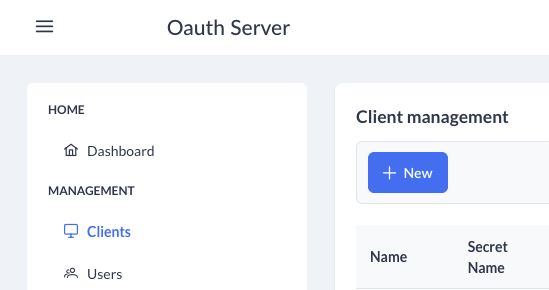Ingress Authentication
This page documents the usage and integration of the Ingress Auth feature of the SSO Bridge, designed for use with the Kubernetes NGINX Ingress Controller.
Overview
The SSO Bridge provides endpoints to enable OAuth2-based authentication for applications protected by the NGINX Ingress Controller. It implements the external authentication flow using the following ingress annotations:
nginx.ingress.kubernetes.io/auth-urlnginx.ingress.kubernetes.io/auth-signin
These annotations allow the ingress controller to delegate authentication to the SSO Bridge, which manages the OAuth2 login flow and session management.
App creation in SSO Bridge
Login to the SSO Bridge and navigate to the Clients tab as displayed below.

Create a new client for your application with the following attributes:
- Name (Name of your application)
- Secret Name (Name of the Kubernetes secret that holds the credentials)
- Description (Description to clarify the exact application)
- Client ID
- Client Secret
- Roles (If you require any roles)
- Grants These should be set to
client_credentials.
Required Ingress Annotations
Add the following annotations to your ingress resource:
nginx.ingress.kubernetes.io/auth-url: "https://<your-sso-bridge>/api/ingress-auth/auth-url"
nginx.ingress.kubernetes.io/auth-signin: "https://<your-sso-bridge>/api/ingress-auth/auth-signin?clientId=<your-client-id>&rd=$request_uri"
auth-url: Called by ingress to check authentication status.auth-signin: Where unauthenticated users are redirected to start the login flow. Fill in theClient IDof the SSO Bridge application that you just created in the<your-client-id>placeholder.
Example Ingress Resource
apiVersion: networking.k8s.io/v1
kind: Ingress
metadata:
name: my-app
annotations:
nginx.ingress.kubernetes.io/auth-url: "https://example.com/api/ingress-auth/auth-url"
nginx.ingress.kubernetes.io/auth-signin: "https://example.com/api/ingress-auth/auth-signin?clientId=my-example-client-id&rd=$request_uri"
spec:
rules:
- host: my-app.example.com
http:
paths:
- path: /
pathType: Prefix
backend:
service:
name: my-app-service
port:
number: 80
How It Works
- User requests a protected resource via the ingress.
- Ingress calls
/ingress-auth/auth-urlto check if the user is authenticated.- If authenticated, the request proceeds.
- If not, ingress returns a 401 and redirects the user to
/ingress-auth/auth-signin.
/ingress-auth/auth-signininitiates the OAuth2 flow, redirecting the user to the authorization server.- After login, the OAuth2 provider redirects to
/ingress-auth/callback. /ingress-auth/callbackexchanges the code for tokens, establishes a session, and redirects the user to their original destination.
Sequence Diagram
Notes & Best Practices
- The SSO Bridge must be accessible to the ingress controller and users.
- At the moment, you can only use the Ingress Authentication for subdomains or paths of the SSO Bridge location. For example if you host your SSO Bridge on
example.comonly applications hosted on*.example.comandexample.com/*can be used for ingress authentication. - OPTIONAL If you want to use logout, you have to implement the
ingress-auth/logoutendpoint in your own application. This will remove the user object on the session.
Troubleshooting
- If authentication works in a browser but not via ingress, check that the
Set-Cookieheader is present and not stripped by ingress. - Use browser dev tools to verify cookies are set and sent on subsequent requests.
For more details, see the implementation in ingress-auth.controller.ts and ingress-auth.service.ts.